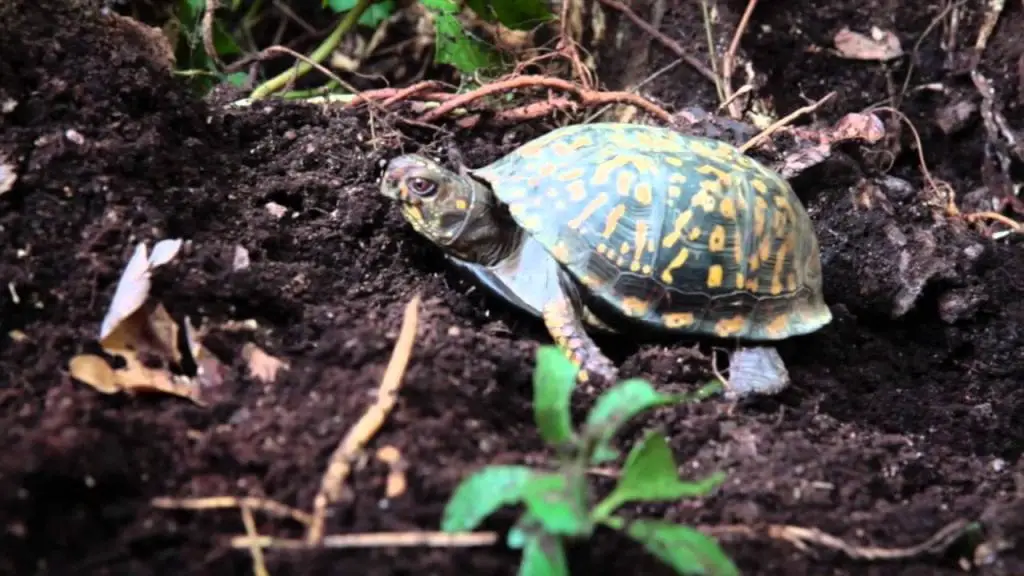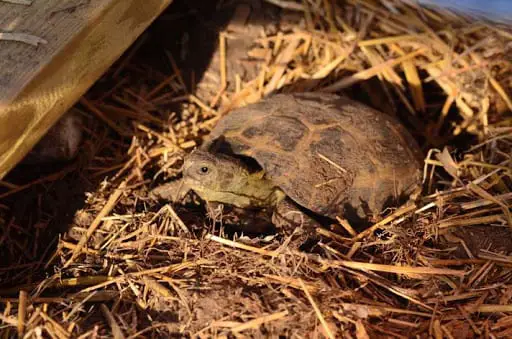When turtles are in their natural habitat, they will hibernate if their local climate gets too cold during the winter months. The sign turtles usually consider are when the temperatures start dropping, the days become shorter, and when the sun sits much lower in the sky. When this happens, turtles and tortoises tend to start preparing for their hibernation. Technically, this period is called “brumation.”
What Is Hibernation and What Is Brumation?
Turtles and tortoises are cold-blooded animals, which means that when it becomes too cold, these animals have problems with digesting their food and moving their limbs. When these factors occur and are combined with the fact that there is less food available for turtles during the winter, it is not a shocking thing to see that these animals work to find a safe and quiet place where they can live out in the winter. Usually, these safe places involve a dugout burrow, which will help them to get below the frost line and in an area under a thick bed of decaying leaves.
On the other hand, there are also some box turtles, aquatic turtles, and desert tortoises, that also encounter a period where they become dormant during periods of extreme temperatures. The essence of this behavior is that the principles of this act and hibernation are very similar. The end game is still survival.
When hot, dry spells occur, it is important that turtles will be escaped to escape the intense heat through hiding under leaves, logs, bushes, and burrowing under the ground, which is all definitely much cooler. This is especially because when turtles or tortoises get exposed to long periods of drought, they can dry out, get dehydrated, and die, or the happening known as desiccation. For this matter, it is very important that you can provide your pet with some sort of cover that they can use, whether they live in an indoor or outdoor pen.
Some Important Definitions
1. Hibernation
This is the term used to define the process of inactivity, usually seen as sleeping, during an extended length of time, wherein an animal has lower body temperature, conserves food by living off fat deposits, and maintains slower breathing.
2. Brumation
This is the term used to describe the way reptiles slow down during times with colder temperatures. In this period, the reptiles often stop eating, and they are seen becoming inactive. The difference of brumation from hibernation is that during this period, they are not really in a sleeping state, but instead, they are in a slower metabolism period that only requires them to eat much less.
3. Estivation
Aestivation or estivation is the term used to describe the process of dormancy or inactivity during the time of extreme temperatures, wherein the metabolic rates of the animals are lowered. This is an activity that helps the animals avoid drying out.
Should A Turtle Hibernate Or Not?
Some turtles and tortoise species hibernate while other species do not. For instance, there are tropical tortoises, like the Asian Box Turtle or the Red-Footed Tortoise that hibernate. While some tropical species, like the Malayan and Keeled Turtles, do not. On the other hand, many of the box turtles that originate from the South Eastern regions of the United States are used to much shorter and colder periods. And, thus, some turtles do not hibernate as long, or they start much later.
Understanding the type of turtle that you have will help you determine what you should do and when the appropriate would be to ease your pet turtle into hibernation. It is always healthy to hibernate these turtles, so you will be able to identify whether they are able and ready.
What Are The Requirements To Stimulate Turtle Hibernation?
You can only start to hibernate your pet turtle and tortoise when you or your turtle are able to answer yes to the following requirements:
- The temperature is about 10 degrees Celsius or 50 degrees Fahrenheit.
- The turtle is at a healthy state with no signs of disease, illness, or concern.
- The turtle has no swelling in its head, including infections in the ears.
- The turtle has no open wounds that need to heal.
- The turtle is not suffering from flaky and dry skin, without any vitamin deficiency.
- The turtle is not showing any form of discharge from its eyes, nose, and mouth.
- The turtle’s eyes are not swollen or shut down.
- The turtle has no white or light-colored tongue.
- The turtle is not a young juvenile, about a few years old.
- A proper location for hibernating has been provided for them.
How To Prepare A Turtle For Hibernation

Towards the end of every summer, you should make a few changes in the diet of your pet tortoise. You should add more greens in the turtle’s meals, as these meal options include vitamin A. If you prefer, you can opt for choosing to add a cod liver oil supplement to your pet turtle’s diet. You will only need to provide a few drops of oil to supplement the diet of your turtle throughout the entire winter.
As you begin to recognize the turtle starting to slow down its movements and metabolism, like decreasing its food intake and attempting to dig a burrow, you will be able to note that it is time to prepare for hibernation.
When this point happens, you should stop feeding them and allow them to soak every day, so that they will be able to clean out their digestive tract. If there is food left in the stomach of the turtle, the intestine of the turtle can rot, and it can lead to health problems. Before you place them away for the winter, you should also never forget to soak them for one last time and inspect them for illness.
Preparing For A Turtle That Is Kept Outdoors
When in the wild, turtles start to hibernate outside, which means domesticated turtles will be able to survive outside as well. But, take note that it is only possible if the climate that you have outdoors is very similar to your usual temperatures inside your home. However, it is not easy to check up on them when you leave them outside to check out if they are feeling healthy. A risk of keeping turtles outdoors is leaving animals open to pests and predators.
If ever you decide to keep your turtle’s outdoors, make sure that you secure your chosen hibernation chamber so that the predators will not be able to harm them. This can simply be done by keeping them underground, which is about two to three feet wide and two to three feet deep. You should just make sure, though, that the area is not prone to flooding.
Next, you should also fill the dug hole with some grass clippings, moss, and mulch, as well as moistening them all. Once the turtle is placed inside the pit, you should allow your pet to dig down before placing additional mulch and leaves on top of them. You can also add some plywood on top of the entire pit to keep rain and predators away.
Preparing For A Turtle That Is Kept Indoors
If you are considering an easier method, it is still better to hibernate your tortoises and turtles indoors. You can use a barn, shed, or a garage that is powered by electricity. This method will allow you to control the temperatures inside and make sure that your turtles are still doing okay much easier.
You can actually build a box or use a storage bin that you can use as a hibernation tank. To do this, you can get a container and fill it with packaging materials like Styrofoam peanuts. Then, place another box inside that is filled with a substrate or some shredded paper. Finally, place your turtle inside the box and loose closely close both of the lids. Do not close the box airtight because your turtle might get suffocated. Make sure to add some ventilation holes in both of the boxes as well. Place the box on a shelf on a shelf or an elevated space to keep the bugs out.
Try Keeping A Turtle In A Refrigerator
If you own box turtles, you should know that you should not keep them inside without allowing them to hibernate inside a heated home. They will not be able to hibernate if the environment is not cold enough. You can use this method of placing the turtle inside the refrigerator with the temperature set to 45 to 50 degrees Fahrenheit. You can utilize any container, just place some substrates inside. You should also open the door of the refrigerator a few times a day so that you can provide them with fresh oxygen.
The Time To Wake Your Turtles Up
Eventually, you will have to emerge the turtles from their brumation and hibernation state. Usually, you can do this when the temperatures start to get above 50 degrees Fahrenheit during the evenings and about 60 degrees Fahrenheit during the daytime. They might not eat right after they wake up, but make sure that they have food and freshwater available for them. Finally, you should inspect your turtle for possible health concerns and treat any issues you notice right away.



